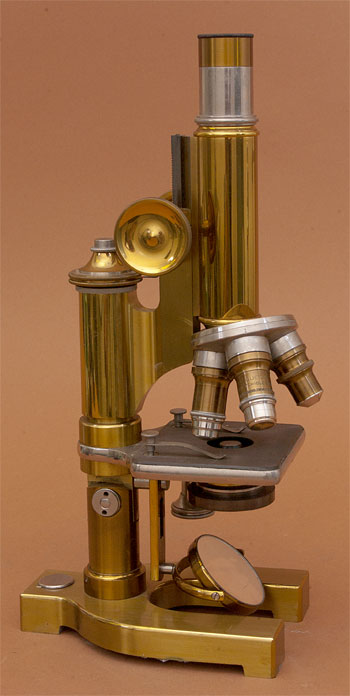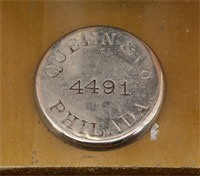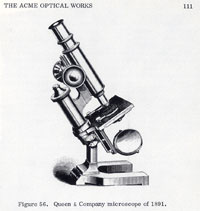 |
|||||
 |
 |
||||
 |
|||||
 |
 |
||||
James W. Queen & Company Acme Continental Microscope (No. 186) |
||||||||||
 |
||||||||||
| Age: c1898 Made by: James W. Queen Made in: Philadelphia |
||||||||||
 |
||||||||||
 |
||||||||||
|
Acme Continental Stand
|
||||||||||
| James W. Queen & Company was a large scientific instrument distributor of the late 19th and early 20th centuries. Their catalog ranged from the inexpensive Acme microscopes to large and more expensive instruments made by European firms. By 1884 Queen & Company published five catalogs of instruments with five supplements, as well as the bimonthly journal: The Microscopical Bulletin and Optician's Circular later to become The Microscopical Bulletin and Science News. The magnitude of their catalog gave them great influence over the development of the microscope during the latter half of the 19th Century, and one of the last great American optical companies.
James Queen (1813–1890) learned the scientific supply trade, starting at age 12, by working with Thomas H. and F.W. McAllister ("McAllister Brothers") in Philadelphia. In 1836 James became a partner and continued to work with McAllister until establishing his own business in 1853. From that time until his death the Queen company grew, eventually distributing hundreds of different scientific instruments from a number of American and European manufacturers. In 1870 the John W. Sidle Company, manufacturers of the "Acme" brand of microscopes, merged with Queen & Company and the "Acme Optical Works" became James W. Queen & Company, and in that same year the Company became the sole agent in the US for R&J Beck. The 1870 Queen catalog had over 100 pages of scientific instruments, including microscopes made by Zentmayer, Hartnack, Nachet, Henry Crouch, R&J Beck (their full line of microscopes), Reichert, and, of course, the Queen Acme line. These digital examples of Queen & Company catalogs attest to the breadth of items offered. By the late 1880s Queen & Company was a major force in the scientific instrument trade in the US, as is shown in this Scientific American article of 1888. The Company continued to offer microscopes made by other firms, but by 1896 it had acquired enough patents and engineering expertise to began making all of its own high-magnification, achromatic objectives rather than importing them. However, reorganization of the company in the early 1900s resulted in Queen & Company eventually moving out of microscopes while it concentrated on other instruments such spark coils and other devices pertaining to electromagnetism. The last known advertisement for microscopes appeared in 1904. By 1910 Queen's only products were electrical test equipment. The Golub Collection Microscope No. 186 is a fine example of the Acme Continental Stand microscope distributed by James W. Queen of Philadelphia and made by J.W. Sidle Acme Optical Works. This instrument is representative of the last microscope made by the Sidle Company: the "Acme Continental" microscope. Introduced in 1891, the Acme Continental microscope had the same basic configuration of all "Continental" microscopes. It has a horseshoe base with a single-pillar support with an integrated fine focus mechanism. This instrument has a round lower support pillar with a pivot allowing the microscope to be tilted. The nosepiece is markedly improved from the original design in having a four-position rotating nosepiece. Coarse focus is via Rack & Pinion attached to the support limb whereas fine focus is via a fine-pitch screw mechanism in the circular support pillar. There are four objectives, two dry and two high-NA oil immersion. Illumination is by a substage reflecting mirror. The condenser is the Abbe-type with an adjustable iris. This microscope has a single eyepiece. On the base tailpiece is the Queen & Co. logo and the serial number 4491. The microscope is 34cm tall. For more information pertaining to James W. Queen & Company consult this book. |
||||||||||
Microscope featured 03/2012